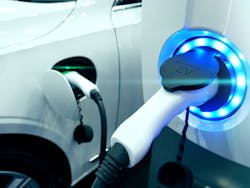It Wouldn’t Take a Lot of Electric Vehicles to Shift Residential Peak Demand: Study
Functioning as a virtual power plant (VPP), it would take just 10% electric vehicle (EV) market penetration in Southern California Edison’s (SCE) service territory, 5,000 customers, to shift residential peak power load to evening hours, according to an independent, self-funded study from Jackson Associates.
“We were surprised both at the relatively small 10% EV market saturation required to completely clip the SCE residential peak and the large annual savings of $560/EV per customer even after paying for nighttime recharging,” said white paper author and company president Jerry Jackson. “These results suggest that utilities should shift from defensive, managed charging strategies to an offense strategy that draws on electric vehicle battery storage during peak hours with overnight recharging.”
The EV battery power “offsets the increase in electricity use of other customers that typically occurs in these four hours, thus clipping the peak from the utility’s perspective,” Jackson said in an interview.
Reducing residential peak power demand down to zero
Jackson Associates chose SCE because the analysts wanted an area that had a reasonably high level of summer air conditioning load and would benefit from an VPP based on peak and off-peak electric price differentials, Jackson explained.
“Reducing EV customer electricity use to zero in each of the four peak hours by drawing on EV battery power offsets the increase in electricity use of other customers that typically occurs in these four hours — thus clipping the peak from the utility’s perspective” he told Microgrid Knowledge.
Jackson calculated an average utility cost savings to consumers of $560/year by doing so, and a net cost savings of of $400/year when the customers’ costs of additional charging cycles was added in. “There will be some utility costs to provide the infrastructure and run the program; however, most of the costs savings should flow through to customers, Jackson commented.
Significant reductions in greenhouse gas emissions
Shifting EV loads away from peak periods would also contribute to California’s goals of reducing greenhouse gas emissions and achieving zero-carbon energy, Jackson pointed out. “EV VPPs can play a huge part in eliminating the need to employ more expensive and less climate-friendly peaking power plants.”
He added that natural gas peaking power plants reduce emissions since fossil fuel peaking plants tend to have greater emissions. “Solar won’t provide any of the nighttime charging unless coupled with utility scale batteries. Wind could be a resource employed for this purpose.”
The benefits of an electric vehicle VPP vary by utility and require analysis of individual customer residential hourly loads, commuting behavior, and relative cost of on-peak and off-peak power, Jackson explained. Jackson Associates analyzed SCE customers’ hourly loads, commuting behavior and potential for electric vehicle ownership to carry out the study.
The white paper is the first electric VPP analysis to provide publicly available data based on individual utility customer’s hourly loads and commuting behavior, according to Jackson. Researchers drew customer data from the MAISY Utility Customer Hourly Loads Database.
“There haven’t been any published studies similar to this. There are lots of mentions of virtual power plants and electric vehicles on the Web but they are mostly concept pieces,” Jackson said.
States are working towards implementing institutional frameworks to support and foster EV sales, use and incorporation in microgrids and other distributed clean energy systems.
Join Microgrid Knowledge’s LinkedIn Group, Distributed Energy Resources, for more discussion about electric vehicles and virtual power plants.







